








By Alejandra Gallo STAFF WRITER
The MOSAIC Cross Cultural Center hosted the grand opening ceremony of the new prayer space at San José State located at the Boccardo Business Complex, on Thursday.
The MOSAIC Cross Cultural Center is a resource center for students on campus that hosts events related to diversity and empowers students by advocating for their voices, according to an SJSU web page.
Cheska Dolor, a program coordinator at the MOSAIC Cross Cultural Center, helped coordinate the event.
“We have been trying to open this new prayer space for about four years now,” Dolor said.
Souhaib Balmane, a third year business administration student, said the new prayer space was needed because he and other Muslim students must pray numerous times throughout the day.
Islam is one of the three major religions of the world, , according to a Sept. 7, 2022 article from The Economic Times.
Muslims must pray five times a day, which is known as the Salah, according to the same article.
The first prayer starts at dawn and ends at sunrise, the second starts post-noon and ends at the beginning of the last part
of the afternoon, the third begins during the later part of the afternoon and ends before sunset, and the final prayer begins at night and ends just before dawn, according to the same article.
“Without the prayer space, it would be really hard for us (Muslim students) to find a space to pray,” Balmane said. “Students who live far from home would have to go home and pray, and then come back to school which is a big inconvenience.”
All five prayers include
Accommodations Task Force.
Prostrating to Allah is a symbol of repentance, worship and praise, according to a web page from Understand Al-Quran Academy.
At the event, Albaraa Basfar, a postdoctoral researcher at Stanford University, spoke about the importance of having a designated prayer space for Muslim students.
Basfar sang part of a prayer from the Quran and read some of the scripture pertaining to praying in the
inadequate for Muslim students.
“The old prayer room lacked ventilation which isn’t good because when we pray, we need to wash certain parts of our body like our hands, face and arms,” Awais said. “It was very difficult to do that in the past prayer room.
A Muslim prayer room on campus must be centrally-located and be accessible to students, according to an article from the Muslim Accommodations Task Force.
It is useful for the room
Teniente-Matson said she was delighted to see the new prayer space come to life.
“When I came to San José State in January of 2023, it became clear to me from students that the prior space that we had was not sufficient,” she said.
Teniente-Matson said the prayer space took 17 months to complete.
“There were other problems with the room because there was only one shared space for men and women, but we had to pray separately,” Awais said. “If there was a boy in a room praying, we would have to wait for him which caused inconvenience because ideally, there would be two rooms, one for girls and one for boys.”
prayer space will make it easier for students to be able to focus on school and also their religion.
“I used to have to change into my praying outfit and then go to Tower Lawn to pray which was uncomfortable and not ideal,” Balmane said. “But I think the new prayer space is definitely going to make things a lot easier for Muslim students.”
Albaraa Basfar mentioned that Muslim students need a proper space to pray.
Basfar read out loud from Chapter 24 Verse 36 of the Quran.
Without the prayer space, it would be really hard for us (Muslim students) to find a space to pray. Students who live far from home would have to go home and pray, and then come back to school which is a big inconvenience.
Souhaib Balmane Third year business administration student
bowing and prostrating to Allah, the Arabic word for God and reading the Quran, the central religious text of Islam, according to an article from the Muslim
Islamic community.
Maryam Awais, an applied mathematics second year at SJSU, believes the past prayer space at the cultural center was
to have shoe racks, since Muslims remove their shoes during prayer time, according to the Muslim Accommodations Task Force.
SJSU President Cynthia
Dolor said the new prayer space now has two separate spaces for men and women.
“It took us some time to find adequate space to accommodate all the needs of the students,” Teniente-Matson said.
In the Islamic community, both men and women must wear specific clothing when praying, according to a website from the Islamic Association of Raleigh.
“Men must wear a robe and women must cover their hair with a hijab,” Souhaib Balmane said. “The idea behind this is to dress modestly to show respect.”
He said he believes the
“That light shines through houses of worship which Allah has ordered to be raised, and where His Name is mentioned,” he said. The event concluded with students coming together to participate in the evening prayer.
“I think that the new prayer space shows that the school cares a lot about Muslim students and they are showing a lot of respect towards our religion which I appreciate,” Balmane said. “I’m really happy with this new space.”

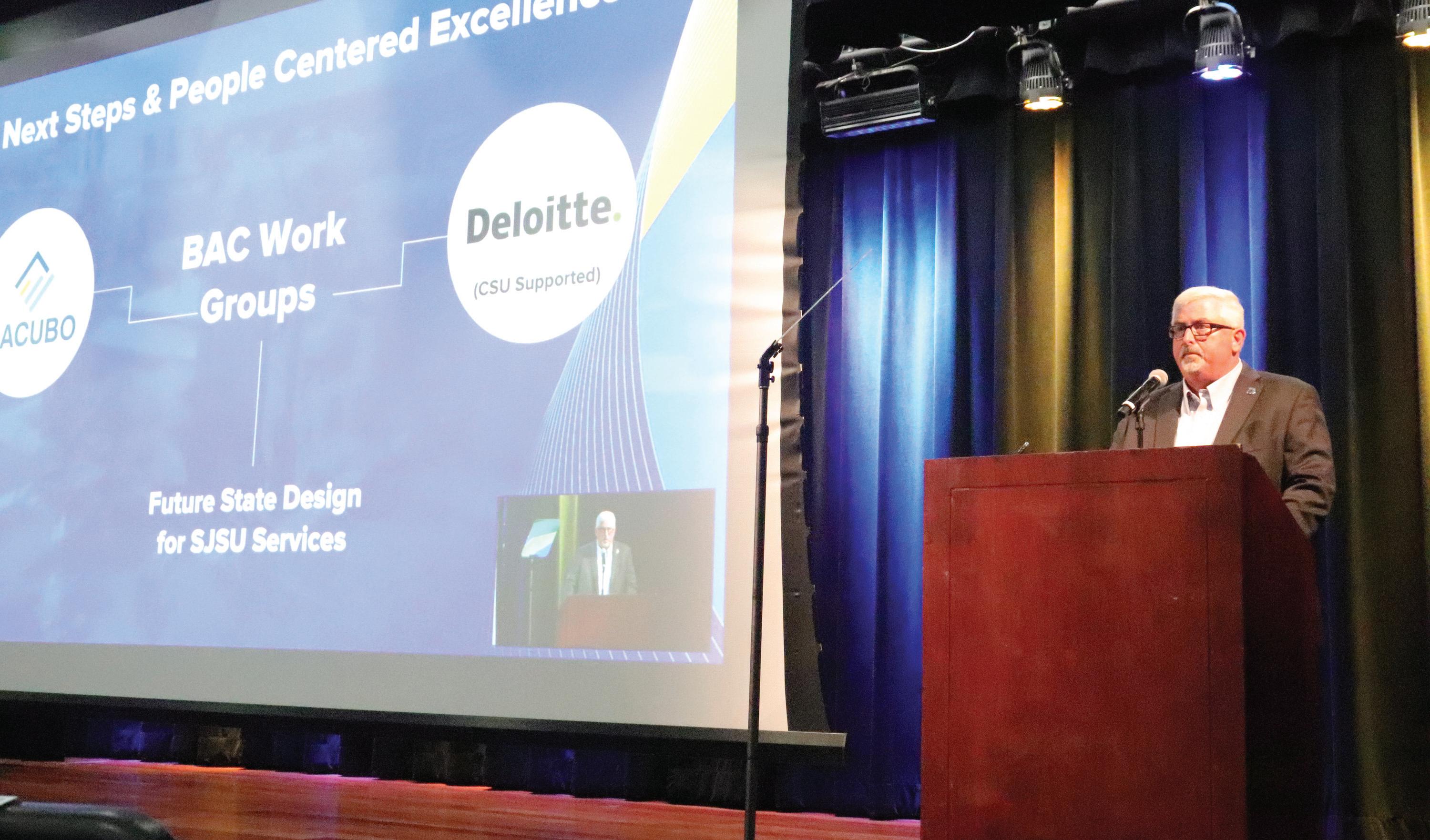
By Israel Archie STAFF WRITER
Many students, staff and faculty came to the Student Union Theatre on Thursday to learn more about the financial budget of San José State at the Budget Town Hall.
Charlie Faas, the vice president for administration and finance, helped deliver the budget agenda along with other SJSU cabinet members.
“The idea here is to repeat and make sure that people understand what we are approaching on our budget,” Faas said.
Maureen Pasag, the senior associate vice president of Finance and Business Services, and Ryan Ward, director of Federal Relations, did a brief overview of
the school’s budget and talked about how the school’s budget is formed.
“The amount is proposed by the governor, decided by the legislature with the final approval of
said that 50% of the budget comes from the state budget with the money that funds California State Universities (CSU) and the other half comes from enrollment revenue
goes toward operating costs including financial aid, utilities, travel and contracts.
Associated Students President Ariana Lacson was in attendance and
The budget is how the university is able to do anything. It is important for students and staff to be able to listen to the issues that are occurring on campus and how those issues are going to be tackled.
Chima Nwokolo AS vice president
with the budget and how it affects students,” Lacson said.
Lacson said she was pleased with the increase in enrollment compared to the previous academic year saying that the school is a “better place” because of it.
Karthika Sasikumar, the academic senate chair and political science professor, said she is also impressed by the increased enrollment.
“I was heartened to learn our enrollment was strong,” Sasikumar said.
Ward said there are factors of the budget that the school can not control such as the gradual budget cuts in the CSU system based on the projected outlook for 2025-2026.
Karlen Kirkland, an SJSU institutional research analyst, expressed concerns about the stress levels of the school’s personnel when it came to budget cuts.
the governor,” Ward said.
He also said SJSU has a budget of approximately $482 million for the 2024-2025 school year.
Pasag went more into detail about where that money comes from and
streams.
She also said that SJSU’s budget has a 80/20 distribution ration meaning that 80% of the budget goes to employee salaries and benefits while the 20% that is left
found the town hall to be very informative and useful.
“As president it is important for me to be knowledgeable about these things and see how the university is dealing
Sasikumar said she is concerned about the budget cuts when it comes to the stability of the school’s budget given that the CSU funds half of the school’s budget.
While some people left feeling pretty good about the school’s budget some also left with concerns because of the instability in finances on the state level.
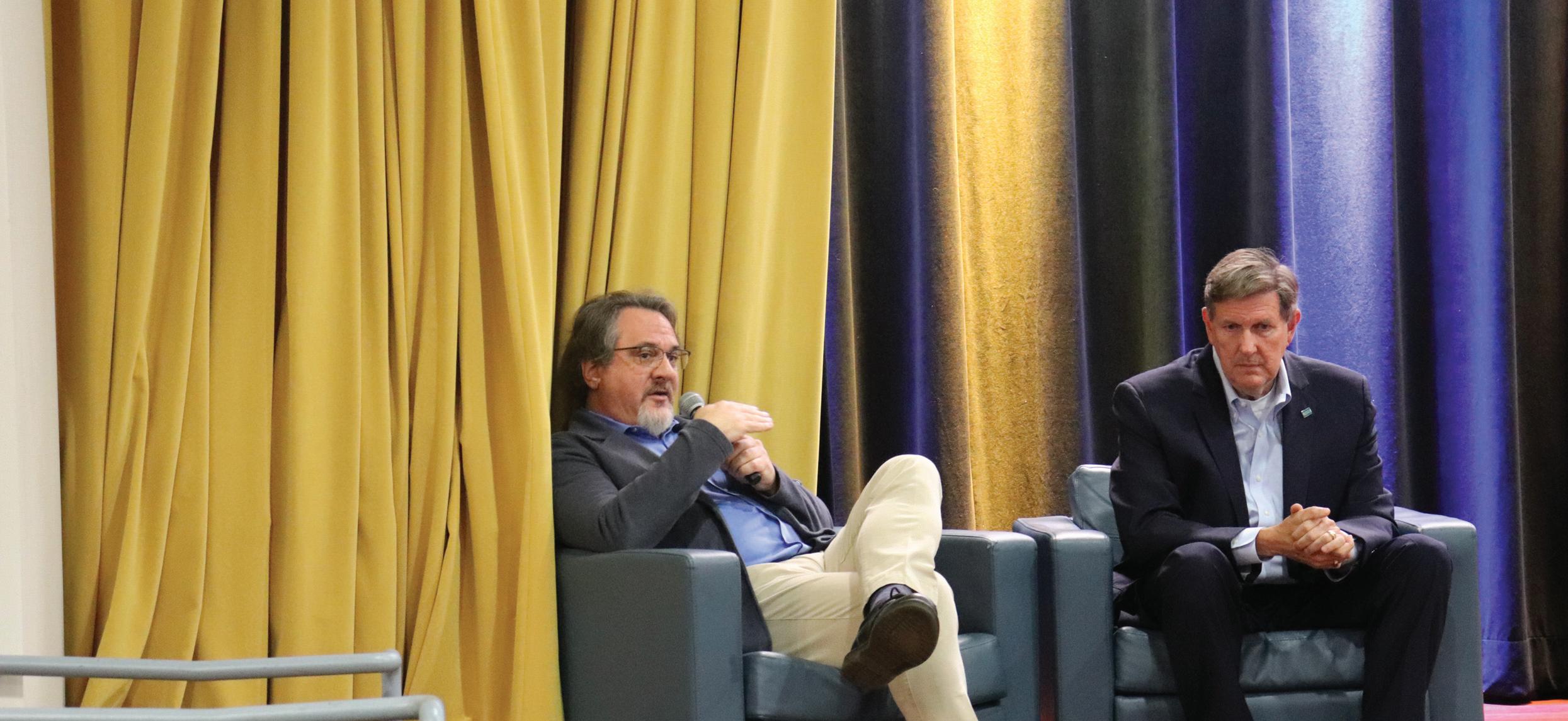
“Another concern I have is the effects on SJSU ratings due to having a high student to faculty ratio,” Kirkland said. “We might not have enough professors to fill the classrooms.”
AS vice president Chima Nwokolo expressed the importance for students to attend these meetings.
“The budget is how the university is able to do anything,” Nwokolo said. “It is important for students and staff to be able to listen to the issues that are occurring on campus and how those issues are going to be tackled.”
Nwokolo went on to mention how important it is to have foresight when looking at these things in addition to thinking about the current effects that budget might have on campus.
“Even though I am not going to be here much longer it is still important to be able to have a perspective of the future of our students who are going to be here years after me,” Nwokolo said.

By Israel Archie STAFF WRITER
San José State’s Tower Lawn was the spot for mingling with the community as the Black Leadership and Opportunity Center (BLOC) hosted its fifth annual BLOC Party on Thursday.
The event was filled with music provided by SJSU alumni and DJ Quam Akande, dancing and other activities such as hula hooping.
BLOC Program Coordinator MyShaundriss Watkins said she was very pleased with the event turnout, using this event as a way for people to learn more about what SJSU has to offer.
“I think the event has been very successful,” Watkins said. “Students
I love to get back to my community. It’s one thing that I have always been very proud of.
Meinliah Kaye
Peer Success Ambassador Black Leadership and Opportunity Center
have come out and learned not only about campus resources but also resources that are here in San José within the local community.”
Some of these resources included free on-campus tutoring organization Peer Connections, the Office of Diversity, Equity, and Inclusion which focuses on systemic change for all students and baked goods from BLOC Peer Success Ambassador Rosalia Black.
Black said she has her own baking company, RB Desserts, and used this event as an opportunity to promote her custom pastries business.
It’s good exposure for my business, but it’s also good networking for me as a student and as a person,” she said.
The second year management information systems student also said she enjoyed the community aspect of the event and urges students to come to more events like these.
“I think it is a great thing especially for new students to come out and see what the community has to offer,” she said.
The sense of community seemed to be a big highlight of the event.
Meinliah Kaye, another Peer Success Ambassador for the BLOC shared some
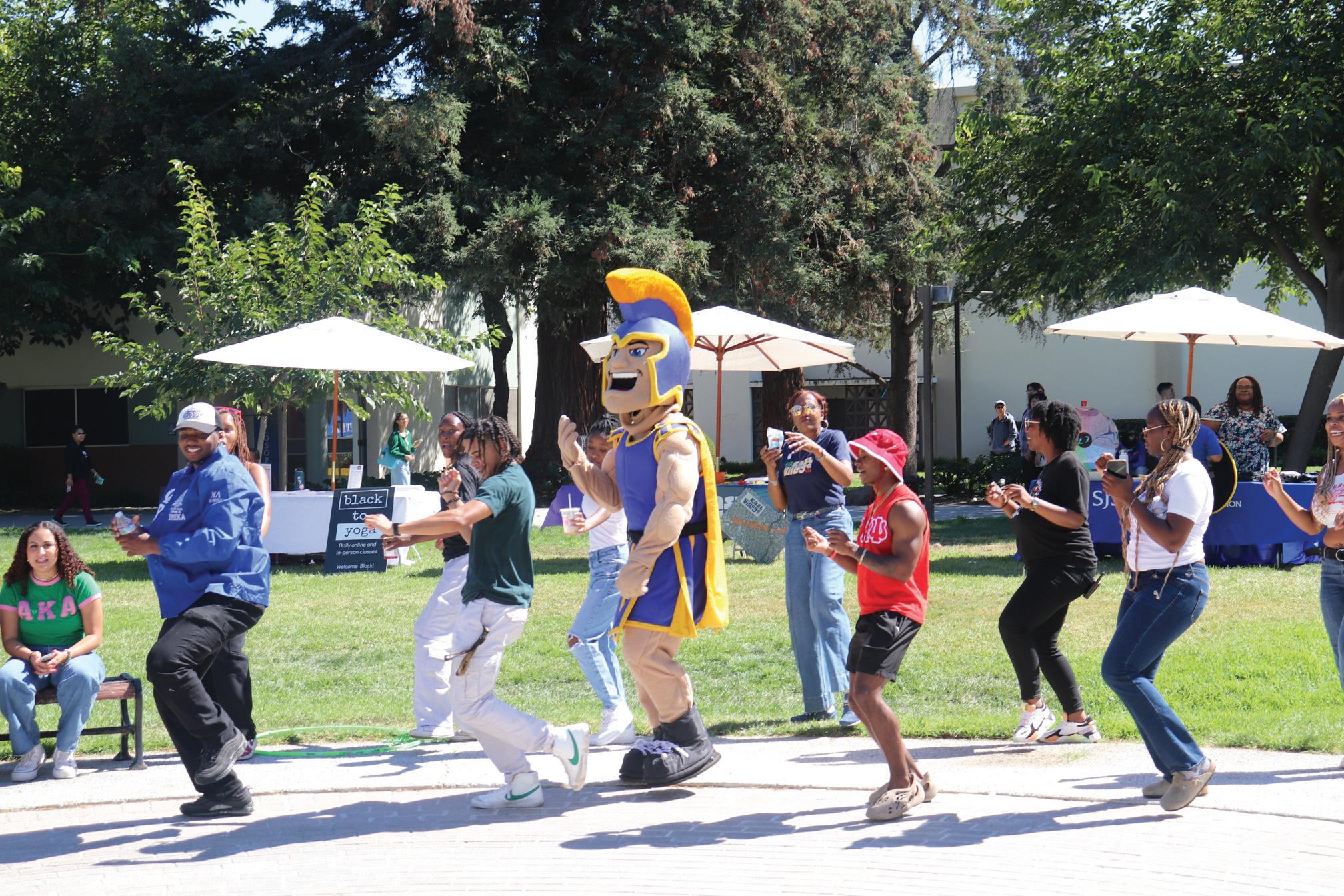
more insight on the effect of community on campus.
“I love to get back to my community,” Kaye said. “It’s one thing that I have always been very proud of.”
Multiple AfricanAmerican organizations came out to show SJSU students what is in store for them. Some of these organizations included the Black Student Union, the Nigerian Students Association and the African
American Community Service Agency.
Like Black, Kaye also mentioned the importance of holding events like these on campus for students.
“Most of the time people won’t even know where to look,” Kaye said. “Coming to these kinds of events they show you where to go. They get a chance to see the faces behind the names of these organizations.”
The third year political
and data science double major used the word “umoja” to describe the different clubs and organizations coming together for this event, calling it her favorite part of the event.
“Umoja” is the Swahili word for unity which seemed to be well represented at the BLOC Party, according to The International African American
Museum web page.
“Sometimes, it is difficult for students to go to faculty and staff, but at an event like this, students can see faculty and staff,” Watkins said. “I hope that not only do they hear that we are here to support them, but they feel that we are here to support them.”
Follow Israel on X (formerly Twitter) @archie45760

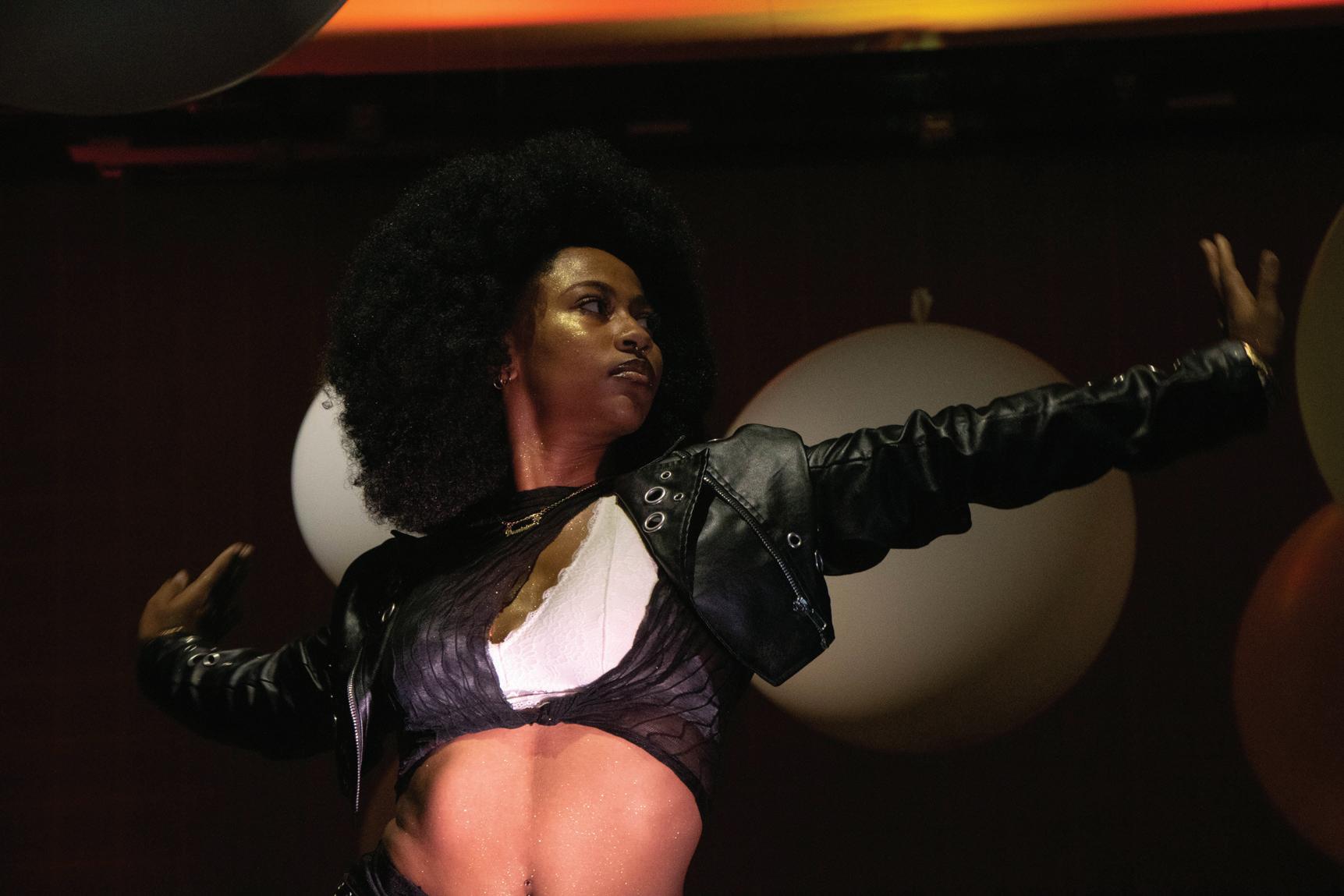

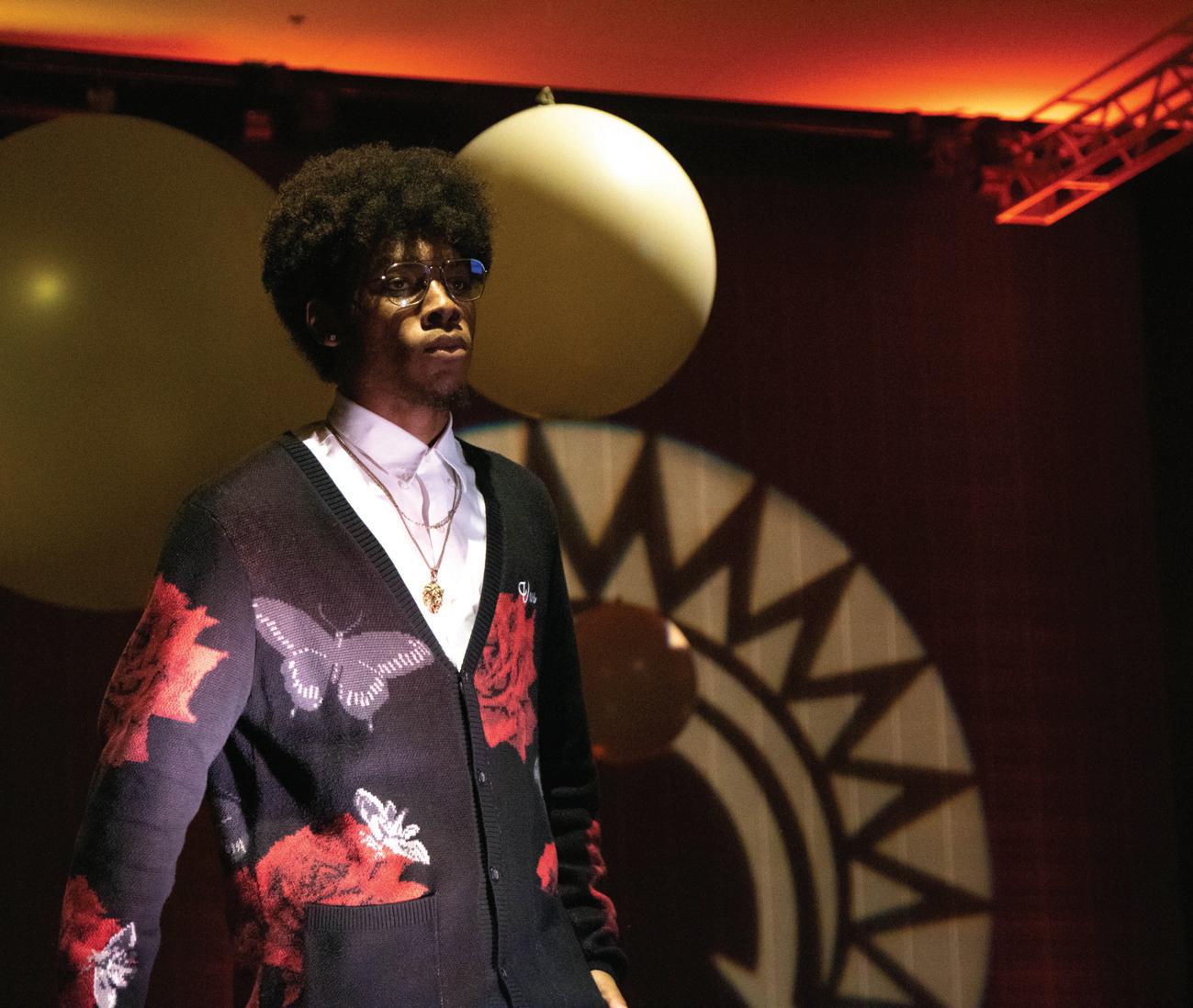
another shirt and a skirt on stage.
By Hunter Yates STAFF WRITER
San José State community garden provides a safe space for students to grow and relax in between classes.
The community garden was established in 2014 as a result of student advocacy, according to a Feb. 24, 2021 Spartan Daily article.
It gives students a place to have access to healthy food through the Spartan Pantry, knowledge about the right ways to develop organic garden practices, as well as receiving credit for SJSU courses, according to the community garden’s web page.
SJSU garden coordinator Ruby Howard has been managing the volunteers and employees since May.

“We harvest all our food for the Spartan Pantry a couple times a week and we care for the plants, by weeding, pruning and watering,” Howard said. “A lot of our beds are on a drip system, so we don’t actually have to water most of them and to check there’s no pests or diseases.”
The community garden doesn’t use any synthetic fertilizers or pesticides meaning everything that is grown throughout is organic, while also following fundamental practices of permaculture, according to the same community garden web page.
Permaculture is a way of living by making sure that resources are being augmented in terms of tending to a garden, using solar power and composting, to maximizing sustainability, according to a permaculture article.
“We have a total of four student staff, (and) they’re here everyday and do a lot,” Howard said. “We have a lot of volunteer support at this time of year, everyone is excited to be back in school.”
The volunteers are first introduced to the staff, and are instructed to walk
around and familiarize themselves with the area.
Shortly after, they are told to make a friend and work together as they are never truly left alone without the supporting staff of the garden.
Volunteers are then instructed by the staff on what to do when it comes to watering plants and or pruning.
Pruning is the removal of certain parts of a plant, living or dying to extend the lifespan, according to an Ambius web page.
“It's important that we have solar for the garden, it was actually a
student project with the engineering students,” Howard said. “It’s a good example of a student sustainability project and how we could be more sustainable in the garden.”
Aashiv Bajaj, an SJSU graduate student and program assistant, has been part of the community garden staff for eight months.
“When I arrive for my shifts at the garden, the first thing I do is check the composting bin,” Bajaj said. “Some people in the community drop off their compost for us to use later on for the plants.”
Volunteering for the garden is on a first come, first serve basis for students and members of the community who sign up through its Instagram.
“If someone wants to volunteer, there is no need for previous experience,” Bajaj said. “It is very easy for anyone that wants to be a part of the experiences here.”
Karan Ghura, a fourthyear civil engineering student, previously volunteered for the community garden.
“I volunteered three times in total at the garden, I planted some
garlic and we cleaned some compost containers as well,” Ghura said. “As a volunteer, you can learn a lot of things about gardening and the correct way to tend to the plants.”
There are around 60 different species of plants throughout the garden which vary from flowers, herbs, fruits and vegetables, according to its web page.
Howard, the garden coordinator, said the community garden maintains the plant beds based on the previous garden coordinator, Matthew Mangoni.
“We group the plantings in the beds based on country or region,” Howard said. “(He) was really good about making sure that whoever entered the garden was able to see their culture represented in what is growing here.”
She said some plants that are featured in the garden are a banana tree, a passion fruit plant and herbs such as parsley.
“It was a fun experience and learning about the variety of plants,” Ghura said. “I didn’t realize how many plants the garden actually has and it was a very educational experience.”

By Mat Bejarano THE SPEAR
OAKLAND — It was a gloomy day as 46,889 fans packed the Oakland Coliseum one final time to watch their beloved Athletics play their last home game on Thursday.
This game marked the end of 57 seasons that A’s called Oakland their home as the team set its eyes on temporarily moving to the Sacramento Rivercats’ ballpark while their proposed 33,000-seat Las Vegas stadium is being built.
Gabriel Hernandez, a season-ticket holder who vlogs his experiences going to A’s games on his YouTube channel gamer_athletics, said Thursday was meant to reflect on all the people he has met at the Coliseum.
“At the end of the day baseball is supposed to be fun and (Athletics’ ownership) they made this worse,” Hernandez said. “No fan base should ever feel the way I do.”
Fans were allowed early entry with many filing in as the gates opened three hours before first pitch. The team gave out commemorative tickets and a voucher for a mini Oakland Coliseum stadium replica that fans could receive after the game.
The A’s also brought out notable alumni such as Oakland natives Rickey Henderson and Dave Stewart to throw out the first pitch.
Both Henderson and Stewart were key players of the A’s last World Series title in 1989 with Stewart
winning World Series M.V.P.
“The sad part about it is all these people that work here that I saw for decades,”
Henderson said in a San Francisco Chronicle article posted last Thursday. “Some of them, working here is what enables them to get out of bed to go do something. I’m sad for them.”
Barry Zito, former A’s Cy Young award winner was also present to sing the National Anthem before the game.
Athletics owner John Fisher released a statement last Monday in which he said he wanted the A’s to win the World Series and build a new ballpark in Oakland when he originally bought the team back in 2005.
“Though I wish I could speak to each one of you individually, I can tell you this from the heart: we tried,” Fisher said in the statement.
“Staying in Oakland was our goal, it was our mission, and we failed to achieve it. And for that I am genuinely sorry.”
Hernandez said Fisher’s statement was a lie and he thinks that he didn’t even write the statement.
“He didn’t have to write the letter and I think that’s how it should have been,” Hernandez said. “Seeing that letter, if anything angered me more, because I know that's what he's saying is not true.”
Michael Smith, a Castro Valley native and avid collector of A’s memorabilia bought a ticket from the teams’ first game in Oakland in 1968 with him.
“I got too many memories of family and friends here over the years,” Smith said.

“My kids have been here since they were babies. I’ve been here since I was a kid in 1986.”
Smith said he was looking forward to creating one last memory at the A’s game with his wife.
“A win would be the best thing,” Smith said. “Go out with a bang.”
The Athletics would do just that as they defeated the Texas Rangers 3-2 as American League AllStar pitcher Mason Miller recorded a four-out save to end the game.
Smith said despite the move, he is loyal to the Athletics’ brand.
“I’ll never put on another hat,” he said. “Some of my friends might do it but I can’t do it.”
That feeling isn’t shared mutually amongst other
Oakland fans such as Hernandez.
“I won’t cheer for another team, because that's what Rob Manfred wants me to do,” Hernandez said. “He wants me to continue to pay money for another team.”
Hernandez said he won’t be following his fandom of the Athletics to Sacramento or Las Vegas.
Will MacNeil, better known as “Right Field Will,” has been an A’s season ticket holder for 20 seasons and said it’ll be hard for him not to root for the current players going forward.
“I can’t give up on those guys. I love those guys. I’ll still be a fan for them,” McNeil said. “But no, I don’t know if I ever go to Sacramento games, per se, just because I don’t want to give John Fisher any more money.”
Mike Wilkins, a San José resident, said he was looking forward the most to seeing the Coliseum full one last time.
“It’s sad, but I’m also just trying to have one more memory and one more experience,” Wilkins said.
“It’s a lot of thinking back to bringing my kid here for the first time and watching him go through all of the teams and his heart breaks seeing them go away.”
Wilkins, who has been a fan for over 25 years, said he couldn’t see himself rooting for the team but still cheering on the players.
“Hopefully (Fisher) fails and there's another outcome, whether it's a team coming here in some way or another,” Wilkins said. “I think today proves there’s plenty of people in the Bay Area that
would support that.”
The game itself went over smoothly with only some disruption in the top of the ninth inning as two fans ran on the field and multiple smoke bombs were thrown out onto the warning track.
“You guys are going to regret leaving Oakland,” Hernandez said. “I hope more people realize that this can happen to not just the A’s. This can happen to any team.”
